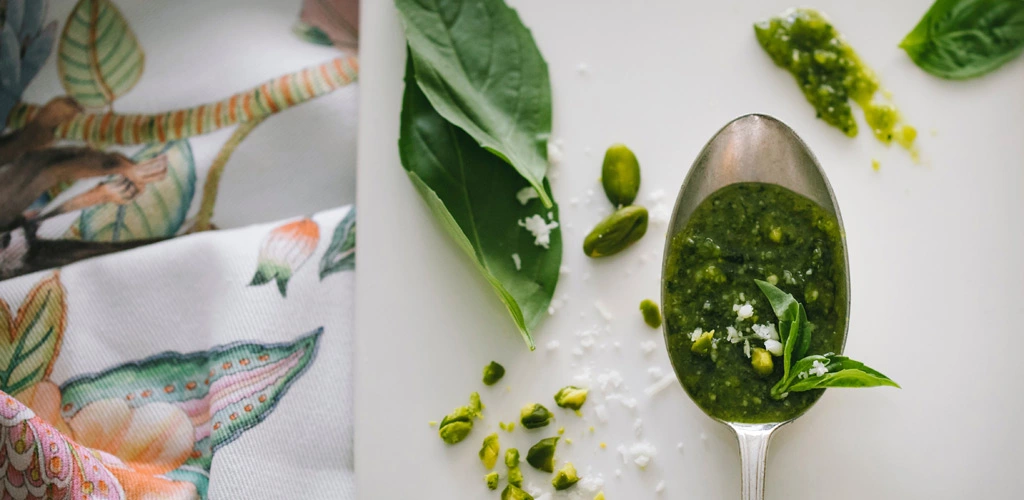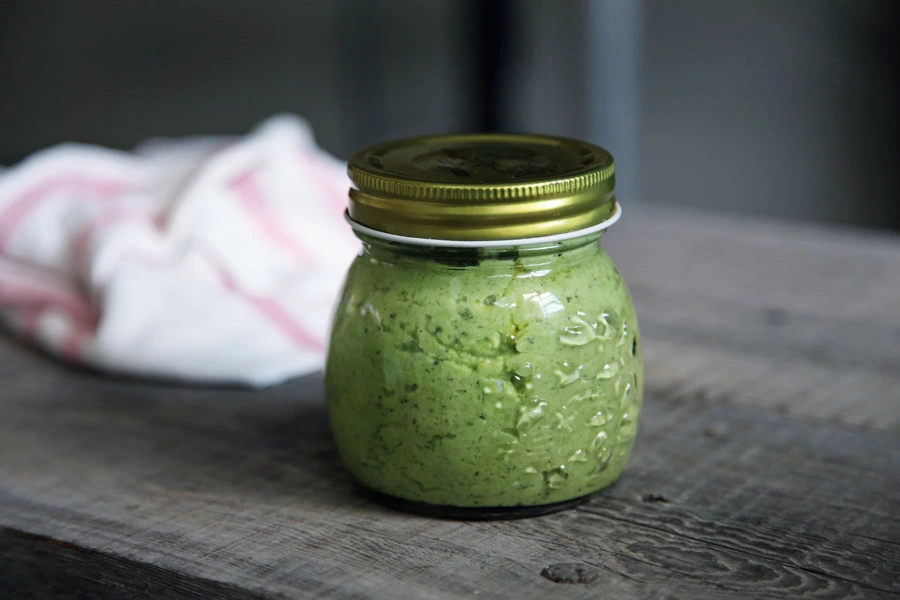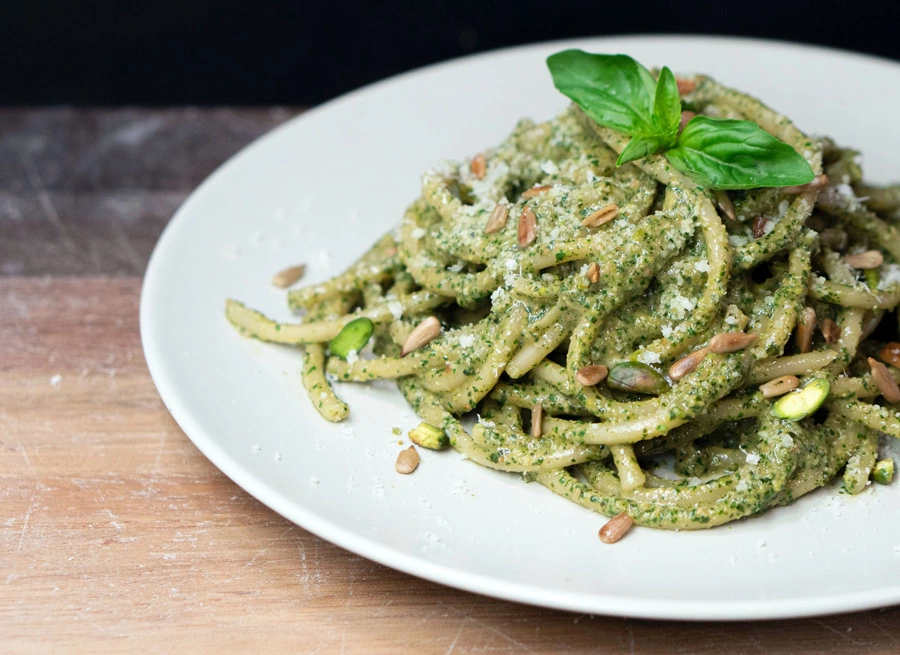Pesto is a delicious sauce that can spice up your meals and make them tastier. But, while this is such a tasty treat, does it mean that you can also share it with your fur baby? Can dogs eat pesto?
Table of Contents
Can your dog eat pesto
The short and straightforward answer is no. This is because there is a very high possibility that pesto contains something that may pose harm to the furry member of your family. Most of the ingredients that are used in and added to pesto may lead to some serious reactions in canines. These can include diarrhea, vomiting, and worse, even long-term damage.

If ever your dog managed to lick some pesto sauce off the counter, or he decided to grab some of your pesto pasta, it is important to contact the vet right away. Also, make sure that you always read and check the label of any pesto sauce before giving it to your pup.
Which ingredients in pesto are dangerous for dogs

The best types of pesto contain high amounts of garlic. This specific ingredient has been the topic of fair amounts of controversy because it is a part of the family of onions that can be very toxic for canines.
Even if garlic can add wonderful flavors for humans, this has the potential of being poisonous to your dog. When given over a long period in large quantities, garlic can lead to anemia that is usually observed in the form of weakness, pale gums, and increased heart rate. However, garlic in small quantities offers a lot of benefits like regulating blood sugar levels, acting as a form of natural antibiotic, and even keeping pesky fleas at bay. It is always best that you only feed garlic sparingly to your pet.
If there are walnuts in your pesto, you need to call your vet right away, particularly when your pet starts vomiting or showing signs of seizures. A single walnut may not cause any negative effects but more than this, walnuts may already become detrimental to your dog’s health.
Walnuts are very prone to the growth of mycotoxin and dogs are very sensitive to this. Macadamia nuts in particular are also known to cause poisoning in dogs. Even if reactions are varied, usually severe but non-fatal, it is best to stay away from these nuts at all costs.
Which ingredients in pesto maybe okay for dogs
Not all pesto contains walnuts. If ever there are other nuts like pine nuts, almonds, and cashews, it is always best to use your discretion. Some dogs are allergic to cashews. You will be the one who knows what is best for your pet as the owner.
Moderation is and will always be the key as far as high-calorie ingredients are concerned like oil, pine nuts, and cheese. Make sure that you always monitor and control your pup’s intake of these specific ingredients.
An ingredient that can boost the flavors of food is none other than salt. Salt is not bad for canines, but excessive amounts of it may lead to sodium poisoning that may even be fatal in the end. You should be extra careful if your pet is suffering from an underlying condition such as heart, liver, or kidney disease. Your dog must always have access to enough amount of fresh and clean drinking water.
Which ingredients in pesto are good for dogs
Herbs are probably the only ingredients in a pesto that you don’t have to worry about. Spices and herbs can be beneficial to your pet’s health because most of these contain essential minerals and vitamins.
Most herbs even offer benefits for your dog’s digestive health and may also have some antioxidant, anti-cancer, and anti-inflammatory properties.
All of these advantages are made possible by the phytogenic compounds present in herbs. Cilantro, rocket, sage, dill, basil, oregano, rosemary, peppermint great for digestive health, and parsley that is an amazing breath freshener for dogs are all perfectly fine, at least in quantities that pesto is typically served in.
However, you should take note that nutmeg and black pepper, which are luckily not found in high amounts in pesto, may have some detrimental effects although these are not poisonous.
You should remember that several herbs may interfere with the medication of your pet. This means that if your fur baby is taking permanent medication, it is important that you consult your vet before you feed them any herbs.
What to do if your dog ate pesto
If your dog ate some pesto, the first thing you should do is check the list of ingredients first. Garlic is that one ingredient that you should watch out for.
You also need to determine the amount of garlic ingested and how much pesto was eaten. Contact your vet immediately. They can advise you if the size of your pet and the amount that was consumed requires your dog to be seen.
It is also important to watch out for symptoms of anemia in your pet. If ever your dog starts to behave differently, call the poison hotline or the vet for professional advice.
The most common signs of anemia that you should keep an eye on include:
- Fainting
- Lack of appetite
- Lethargy
- Pale or light gums
- Red urine
- Weakness
- Wobbly or lack of balance
How to prepare a dog-friendly pesto

Since canines are quite sensitive to all ingredients found in a pesto that people love a lot, the best and safest alternative is to prepare your own.
You can come up with your homemade pesto perfect for your fur baby by taking note of the ingredients you need to avoid at all costs and all those that you can use in moderation.
Below is only a generic suggestion of dog-friendly pesto. Avoid including the ingredients that your pet may be sensitive or allergic to.
The ingredients you will need include the following:
- One cup of fresh herbs
- ¼ clove of garlic
- ¼ to 1/3 cup of grated hard cheese like parmesan
- Small quantity of nuts safe for dogs like four almonds, one brazil nuts, and others
- Your choice of oil if necessary for blending.
Here are the steps for preparing for your homemade pesto:
- Pulse all of the ingredients together until you form a fine paste.
- Store the dog-friendly pesto in the fridge for up to a week.
- You can also freeze it in portion sizes. You can use an ice cube tray for this purpose.
Remember that even if it is a dog-friendly pesto version, you still need to limit the allowance for the sake of your pup’s calorie intake. This pesto should only be restricted to one teaspoon a day for every 10 pounds of your dog’s body weight.
This dog-friendly pesto can be served to your pet as a tonic and as a treat at the same time. This dog-friendly pesto is a great addition to the overall diet of your pup in terms of flavor and nutrition.
As a fur parent, you always want to give your fur babies only the best, and more than anyone else, you are the one who knows them best. Keep a close eye on unusual reactions and behaviors in your pup and stay away from pesto if your dog is allergic to specific ingredients. Call your vet as soon as possible once you observe any form of negative reaction.
Best alternatives for pesto for dogs
Sauces are ideal as toppings for dog food. You can also add these to homemade treats, stuff them into toys, or put them in lick mats.
If you don’t want to give pesto to your dog, don’t worry because there are other alternative sauces that you can use.
1. Cottage cheese
Cottage cheese is a great addition to the diet of dogs that are not lactose intolerant. This is rich in both calcium and protein. If this is the first time that you will introduce cottage cheese to your pet, make sure that you do it slowly since lactose may lead to gastric upset.
2. Plain yogurt
Your pup’s digestive system can benefit from yogurt that is high in calcium in protein and is often used after a bout of vomiting or diarrhea.
3. Dog-safe applesauce
You can use apples, honey, and water to prepare dog-safe applesauce. Honey and apples are both beneficial for canines. Apples contain fiber that helps with digestion are great additions to dog treats and can bind ingredients together as well.
4. 100% pure peanut butter
Rich in vitamins, fat, and protein, peanut butter is often stuffed into toys or added to treats as a binding ingredient.
5. Dog-safe gravy
You can also prepare dog-safe gravy low in salt and with no garlic, onions, or sweetener. You can also make it using flour and low-sodium broths. This gravy can be used to make your dog’s food tastier.

The unique literary talents of Dr. A. Barton are well known throughout the veterinary profession. He is a regular contributor to the New York City Veterinarian and his professional articles have also appeared in the Journal of the American Veterinary Medical Association, Journal of Small Animal Medicine, Veterinary Medicine, Cornell Veterinarian and Philadelphia Medicine. He is the only veterinarian ever to have had an article published in the human medical publication, What’s New.



